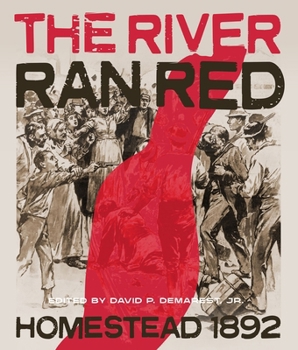The River Ran Red
Select Format
Select Condition 
Book Overview
On July 6, 1892, violence erupted at the Carnegie Steel mill in Homestead, Pennsylvania, when striking employees and Pinkerton detectives hired to break the strike exchanged gunfire along the shore of the Monongahela River. The skirmish left some dozen dead, led to a congressional investigation, sparked a nearly successful assassination attempt on Carnegie Steel executive Henry Clay Frick, and altered the course of the American labor movement. The River Ran Red recreates the events of that summer using firsthand accounts and archival material, including excerpts from newspapers and magazines, reproductions of pen-and-ink sketches and photographs made on the scene, passages from the congressional investigation, and poems, songs, and sermons from across the country. Contributions by outstanding scholars provide the background for understanding the social and cultural aspects of the strike, as well as its violence and repercussions. Written to commemorate the hundredth anniversary of the strike, The River Ran Red records and contextualizes public and personal reactions to one of the most important events in labor history, the reverberations of which are still felt today.
Format:Paperback
Language:English
ISBN:0822954788
ISBN13:9780822954781
Release Date:July 1992
Publisher:University of Pittsburgh Press
Length:244 Pages
Weight:1.45 lbs.
Dimensions:0.5" x 8.5" x 10.0"
Customer Reviews
2 ratings
Disaster on the labor front
Published by Thriftbooks.com User , 18 years ago
This is a concise and well-illustrated account of the deadly strike at the Carnegie Steel works at Homestead, Pennsylvania, in July 1892. When workers' wages were cut despite huge financial gains raked in by the industry because of high tariffs, the Amalgamated Association of Iron & Steel Workers called a strike at the Carnegie mill for July 1. Management decided to treat the strike almost as an outright war on their business, and when Pinkertons were called in to quell the strikers, violence broke out on July 6 in which a number of men were killed. Industrialist Henry Frick was nearly assassinated, and soon troops were brought in to restore order. This book tells the story through contemporary newspaper reports and magazine articles, congressional testimony taken after the event, excerpts from memoirs and other books - all accompanied by many illustrations and photographs. Short essays by modern historians dealing with the technology of steel making, political issues, foreign groups working in the mills, and changes in the laws, among other topics, put the events in perspective. These were dark days on the labor front, and this book captures the mood and immediacy of the strike magnificently. Highly recommended.
Great Firsthand Sources Make this Book a Fascinating Read!
Published by Thriftbooks.com User , 26 years ago
The River Ran Red tells the story of the Homestead Strike of 1892 using firsthand sources (for example exerpts from Carnegie's speeches, local and national papers and even memos from H.C. Frick). This book comes alive more than any other book on the strike because it is told by firsthand sources, not a stuffy historian's view.





